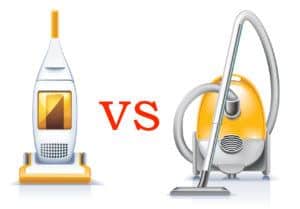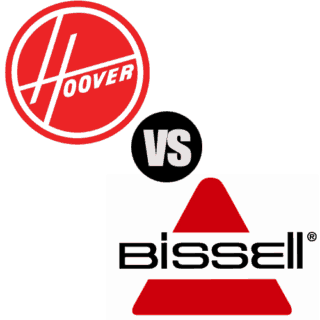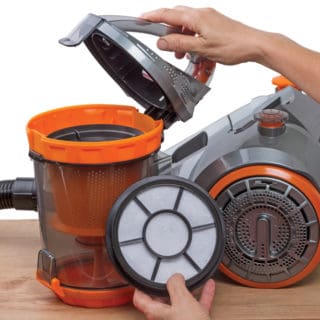
There are two basic types of vacuums that are used in almost every home: canister vacuums and upright vacuums. Many homes, in fact, use both types of vacuums because they can meet different needs.
Canister vacuums tend to be the multipurpose vacuum that is needed for a garage, workshop, or similar location. The design of a canister vacuum makes it possible to replicate the effect of an upright vacuum, but often with an extended reach. It is a solid option to consider for homes that have vaulted ceilings, tight spaces, or difficult stairways that need to be cleaned on a regular basis, especially in homes that have multiple floor types.
Upright vacuums are extremely effective for carpeted areas. Their design makes it possible to cover a large area of carpet in a short amount of time. Coming in bagged or bagless models, you will find options such as HEPA filtration, pet hair removal, and wet/dry combinations available in this category. They can clean stairs and upholstery quite effectively and work on multiple floor types.
In the canister vs upright vacuum debate, there are several key points that must be considered for each design option.
What are the Pros of Canister Vacuums?
#1. They offer a flexible hose and reach option. Canister vacuums are designed to provide the greatest range of motion possible. Between the reach of the hose and the length of the power cord, some models can give users a reach of nearly 50 feet. This makes it possible to clean an entire room or living area without much down time.
#2. They offer a superior level of suction power. Canister vacuums create a high level of suction that resists clogging naturally. Some brands, such as Dyson, promote that their canister vacuums will “never lose suction,” but this is generally true for all brands that use a standard hose with their manufacturing design. Because most canister vacuums use a metal want instead of a plastic one, the rare clogs that do form are quite easy to remove.
#3. They make it easy to vacuum in difficult places. The two places that are often missed when vacuuming are under the bed and under furniture. Canister vacuums are not limited to the upright design, so you can fit the entire vacuum head underneath the bed or furniture in many cases to create a complete clean. And, because the power comes from the canister and isn’t housed in or near the hose, you don’t lose suction by changing the angle of your cleaning attack.
#4. They make it simple to change tools. Because you’re already using a hose and a vacuum accessory with a canister vacuum, tool change outs are a simple process with this type of vacuum design. Look for models that offer on-board storage for the best possible advantage.
#5. They are extremely lightweight. Canister vacuums are designed to be carried or moved around a lot. Many are built with a squared, compact design that will fit on a step so you can clean with ease. Dyson has even created a vacuum that is self-righting if it tips over. This makes it a lot easier to move the vacuum around the house as you’re working on your chores.
#6. They offer HEPA filtration as an option. Many canister vacuums are fully sealed units that offer HEPA filtration. This feature reduces the number of allergens and asthma triggers that may be within a home. Even if you don’t have allergies or asthma, the wrong vacuum cleaner could be contributing to an issue called “Sick Building Syndrome.” With the features and options available through HEPA technologies, the risk of suffering physical symptoms can be immediately reduced.
#7. They offer more wet/dry options. If you need a vacuum for your workspace or garage, then there’s a good chance that you’ll want equipment that can handle wet or dry messes. Canister vacuums are much more likely to offer this feature compared to upright vacuums. Combined with the powerful motor that is equipped to most canister vacuums and you’ll be able to clean up virtually any type of mess with very little effort.
Here are the 10 best canister vacuums which are available right now:
What are the Cons of Canister Vacuums?
#1. They require users to drag them around. Many canister vacuums are not designed to provide easy movement. You must either carry the housing with you as you vacuum or work within its reach so that the unit doesn’t tip over. Sometimes, it becomes necessary to drag or pull the unit with you as you’re working and that is a process that can be awkward for some areas of the home – especially the stairs.
#2. There is usually a requirement for assistance with threshold transitions. Canister vacuums will generally work with all types of flooring, but those with multiple transitions may find themselves a little frustrated with the modern canister vacuum design. If the vacuum does come equipped with wheels, they are usually quite small and provide very little clearance off the floor. This makes it necessary for the user to lift the vacuum to the new flooring area, which increases the amount of down time that is experienced.
#3. It may require changing the head for different floor types. Strong-bristled heads for a hard floor could leave scratches or other forms of damage. Some canister vacuum heads are not designed to get into corners, which requires the user to take the head completely off so the want can be used with precision. To avoid these issues, look for a canister vacuum that offers either straight suction heads or a turbo head or brush roll so that your down time in this area can be reduced.
#4. The design of a canister vacuum requires a bit of a learning curve. Many canister vacuums provide users with a two-piece design, which is similar to that of an upright vacuum. The hose is just longer because the main housing of the vacuum sits lower to the ground. You don’t get to limit the back and forth movement of vacuuming with this design at all. The only difference is that you’re moving an entire wand instead of the entire vacuum and doing that correctly can be difficult to master.
#5. Cleaning carpets other than thin, commercial carpet is difficult. If your home has a plush carpet style, then a canister vacuum is going to struggle to clean it properly. That is why many canister vacuum manufacturers have started offering a motorized head to work with their equipment. Some models have made this motorized accessory standard upon purchase, but many have not. That means if you have a plush carpet, you may need to spend another $40-$60 to get the right tool to use with the wand and that pushes the price of a canister vacuum to the same level as an upright vacuum.
What Are the Pros of Upright Vacuums?
#1. They make it easy to vacuum large areas of carpet quickly. If you have a large room to vacuum, a hallway, or some other space that is carpeted, then nothing beats the speed and power of an upright vacuum. You might find some other vacuum designs are more powerful, while others might offer more speed, but there isn’t another type that can combine the two as effectively as an upright.
#2. They keep the vacuum head in front of you at all times. If you’ve tried to use a canister vacuum before, then you know how tangled up you can get while working. Between the hose and the power cord, you can find yourself stepping over items constantly to avoid tripping. With an upright vacuum, the head is always in front of you. If you manage the power cord properly as you are working, there is never the same threat of tripping that other vacuum designs may offer.
#3. They have more storage capacity for the dirt and debris that is picked up. Upright vacuums that are bagless will typically have a canister that is at least 50% larger than what a canister vacuum can provide and up to 80% larger than handhelds or stick vacuums. Bagged models offer a similar experience. Look for models that allow you to hygienically dispose of the dirt and debris that is picked up while vacuuming for the best possible experience in this category.
#4. They typically have the hose included with the vacuum. You will very rarely find an upright vacuum that sells the hose separately. This allows you to get to work immediately once you’ve put the vacuum together. Canister vacuums may also come with a hose upon purchase, but many users find that they need to upgrade their hose, especially on entry-level models, because there just isn’t the flexibility or durability in the standard hose that comes with their vacuum.
#5. They offer an easy cleanup process. Upright vacuums rarely require you to bend down to empty out a canister when it has become full. You just need to remove either the bag or the dust container from the unit and dispose of it according to the manufacturer’s instructions. Then replace the bag or return the cup and you’re ready to go. Some canister vacuums, especially those with a top-lid design, can create spillage if you lift the vacuum incorrectly or tip it over accidentally. You won’t have that issue whatsoever when using an upright vacuum.
#6. They offer the most convenience out of all types of vacuum cleaners. With an upright vacuum, you simply move back and forth over your carpet to clean it. The equipment is designed to move over the floor easily and requires no excessive movements to control the vacuum cleaner properly. Some manufacturers, such as Dyson, have equipped their uprights with self-regulating heads so they automatically transition to a different type of flooring. Even basic models offer different floor height options that can be manually changed, allowing for virtually any type of vacuum to be thoroughly cleaned.
Here are the 10 best upright vacuums which are on the market today.
What Are the Cons of Upright Vacuums?
#1. The hoses on an upright vacuum are stiff and designed for specific tasks. Users of an upright vacuum will generally use the hose for targeted items that the main vacuum head will not pick up. The stiffness of the hose can also contribute to added clogging, especially if there isn’t cyclonic technology of some type incorporated into the design of the vacuum. If the hose of the vacuum breaks for some reason, it must be completely replaced for the vacuum to become usable once again.
#2. They make it difficult to clean under furniture. Upright vacuums can reach under a bed or furniture to a limited extent. Eventually, the vacuum design will reach a point where the head lifts upward as the user pushes down on the handle and that limits its functionality. Some upright vacuums may not be able to reach underneath an item by more than a few inches.
#3. The design is intended for wide open spaces. It is difficult to maneuver an upright vacuum around furniture or make tight turns with it because of the design. Upright vacuums are intended to clean large areas of wide open carpet quickly and thoroughly. Move this type of vacuum to the stairs or into an area that has multiple corners and it becomes almost unwieldy. Although some uprights are under 15 pounds, the average weight for the modern upright vacuum is above 25 pounds.
#4. There are fewer tool options with most upright vacuums. The average upright vacuum has very few tools that are offered to meet specific needs. You will have crevice tools and a dusting tool, along with a pet hair tool on some models, but that is often the extent of what is received. That makes it difficult to clean higher areas, such as the top of a ceiling fan blade, because there is limited mobility with the accessories and the hose/wand when put together.
#5. The brush roll or beater bar may spread dust and debris. The brush roll or beater bar might leave a nice pattern in the carpet when it is being cleaned, but it may spread out as much dust as it picks up. Whether the exhaust port is on the front or the back of the equipment, you’ll blow dust away as you’re moving back and forth over your carpet. If there isn’t a command to turn off the brush roll on a hard floor, you could kick dirt everywhere and make a bigger mess.
#6. Upright vacuums tend to be more expensive. You’ll find that there are numerous options for canister vacuums that are priced at $100 or less. It is rare to find a good entry-level upright vacuum for less than $100 today. Prices have risen dramatically in this category over the past 5 years. For some upright models, the exact vacuum cleaner that was priced at $70 in 2014 is now priced at $120. Canister vacuums have not seen price increases at the same level.
Canister vs Upright Vacuum Cleaners: Which is Better?
The pros and cons of upright vacuums and canister vacuums are many. Each key point must be carefully considered to determine which type of vacuum can best meet your needs. Both have specific strengths, which is why some homes own one of each type. Each has certain weaknesses as well, which is why some users prefer one vacuum design over the other.
That is why the canister vs upright vacuum debate will likely continue on, no matter what we, you, or anyone else decides about it.
If you’re thinking about purchasing a new vacuum cleaner today, look at the best vacuums in each category. See if the features and services provided will help you be able to create a cleaner home on a consistent basis. If it can do that, then you’ve found the right vacuum cleaner to meet your needs today.
















